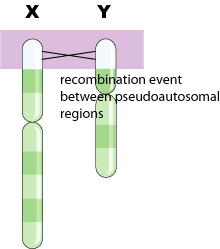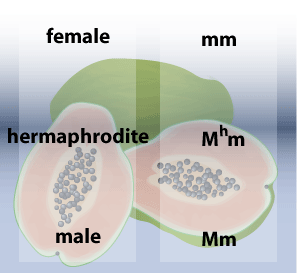THE ORIGIN OF THE Y CHROMOSOME: HOW THE PAPAYA IS PROVIDING SOME INTERESTING ANSWERS TO IMPORTANT QUESTIONS
(August 2005)
The Human Y chromosome
The Y chromosome is the shortest chromosome in humans, and most of the Y chromosome is believed to be made of junk DNA. In the 1960s, Ohno proposed that the human Y chromosome is a profoundly degenerated X chromosome with very few genes on it encoding male-specific features1 and some began to speculate that the continued degradation of the Y chromosome might result in the extinction of the human male.
In order to address this question, it is helpful to know the origin of the Y chromosome. Surprisingly, the most primitive Y chromosome found so far was not found in any animal, but in the papaya (Carica papaya, 2n=18). Liu et al. (2004)[2] found that male and hermaphrodite papayas contain an allele that is not found in female papayas. Severe recombination suppression and DNA sequence degeneration are observed in the regions around that allele. Although no heteromorphic chromosomes in papayas were found to be analogous to the X and Y chromosomes in humans, the newly discovered gene shares many characteristics with male-specific region of the Y chromosome (MSY).

The sex chromosomes of the papaya
In the papaya, the newly discovered gene has three alleles: male (M), hermaphrodite (Mh), and female (m). Females are homozygous recessive (mm); males (Mm) and hermaphrodites (Mhm) are enforced sex heterozygotes; all dominant combinations (MM, MMh, and MhMh) are lethal. This is very similar to humans, where females are XX, males are XY, and YY is lethal. Severe recombination suppression is also observed in the papaya. Using molecular markers and testing 2190 papayas, Liu et al. (2004) found zero recombination in a small (2.5 Mb) region of the sex-determining chromosome.
Recombination suppression has been proposed as the mechanism for Y chromosome evolution. Some scientists hypothesize that once a male-determining allele is formed, cells will suppress genetic recombination in the region around that allele so that the integrity of the allele can be maintained without being disrupted by recombination. However, due to the absence of recombination, the mutations around the male-specific allele cannot be corrected by crossing-over with the female sex chromosome and mutations and junk are able to accumulate in that region. The eventual degeneration of much of the male chromosome may have lead to today’s human Y chromosome, which contains few functional genes. Assuming this hypothesis is correct; more mutations in the region around the male-determining allele of the papayas are expected. Indeed, using molecular markers, more repetitive sequences (due to transposons) have been found around M and M h alleles in papayas 1,3.
A mechanism for the study of the Y chromosome
Liu et al. (2004) suggest that the sex chromosome encoding M or Mh in the papaya is what the human Y chromosome may have looked like 240-320 million years ago. Right now, both the female and male papaya sex chromosomes look identical under a microscope and the male sex-determining gene only spans 10% of the sex chromosome as opposed to the 95% that is seen in the human Y chromosome [1, 2]. However, as more mutations and junk DNA sequences accumulate, more of the non-sex-determining genes on the papaya’s male sex chromosome are expected to lose their functions and degrade. This will lead to a smaller chromosome similar to the Y chromosome present in humans today. It is the degeneration of so many genes on the male sex chromosome that makes a cell with two copies of the male sex chromosome not viable. For example, MM, MMh, MhMh in papayas and YY in humans are all lethal combinations.

The finding in Liu et al. (2004) has many applications. In evolutionary biology, the finding suggests that sex chromosomes evolve from autosomes. In genetics, the finding suggests that suppression of recombination is the mechanism responsible for the evolution of the Y chromosome. In terms of agriculture, the discovery of markers linked to sex chromosomes will help farmers to selectively grow hermaphrodite papayas. Farmers favour hermaphrodite papayas because they are the sweetest and the most productive. Female papayas are sweet but not very productive, and male papayas do not taste as good. Right now, farmers cannot tell the sex of a papaya at the seed stage. It is necessary to plant the seeds and wait until they flower to determine which ones are hermaphrodites. With the molecular markers discovered, farmers may be able to obtain strictly hermaphrodite seeds in the near future.
Liu et al. (2004) shows that the sex chromosomes in other organisms can give us a hint of what the human Y chromosome looked like in the past and the possible mechanisms responsible for Y chromosome evolution. However, Liu et al. (2004) did not speculate about which evolutionary forces are responsible for the emergence of Y chromosome, and scientists are still puzzled by this question today [4]. The future of the research in this field will be firstly to investigate more sex chromosomes in different organisms so that the Y chromosome might be better understood at different stages of evolution. A second concern will be to investigate the interactions between the environment and the organisms with primitive sex chromosomes to find out the evolutionary forces responsible for the emergence of the Y chromosome. Hopefully, further research will enable the prediction of what the future holds for the human Y chromosome.
References
1. Skaletsky, H. et al. The male-specific region of the human Y chromosome is a mosaic of discrete sequencec classes. Nature423, 825-837 (2003).
2. Liu, Z. et al. A primitive Y chromosome in papaya marks incipient sex chromosome evolution. Nature 427, 348-352 (2004).
3. Ma, H. et al. High-density linkage mapping revealed suppression of recombination at the sex determination locus in papaya. Genetics 166, 419-436 (2004).
4. Filatov, D.A. et al. Low variability in a Y-linked plant gene and its implications for Y-chromosome evolution. Nature404, 388-390 (2000).
(Art by Jen Philpot)